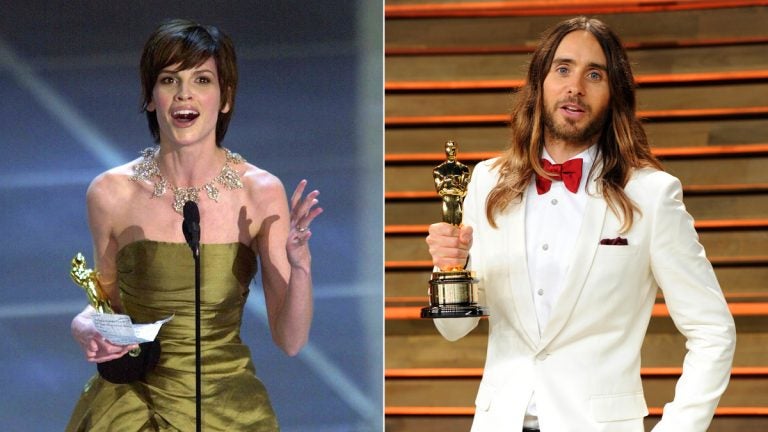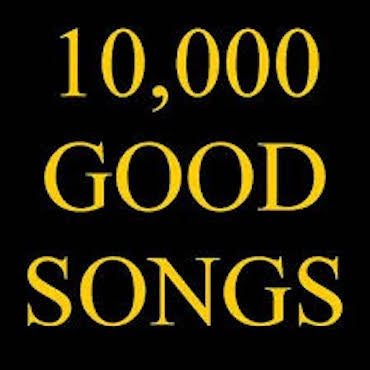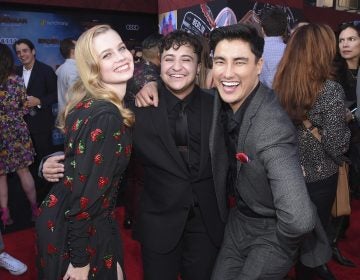Transgender Hollywood seeks recognition, and not just roles
When actress Scarlett Johansson reversed course recently and canceled plans to play a transgender man in the film "Rub & Tug," transgender actors were gratified and surprised.

In this combination photo, Hilary Swank accepts the Oscar for best actress for her role in "Boys Don't Cry" during the 72nd Academy Awards in Los Angeles on March 26, 2000, left, and Jared Leto poses with his Oscar for best supporting actor for "Dallas Buyer Club" at the 2014 Vanity Fair Oscar Party in West Hollywood, Calif., on March 2, 2014. Swank and Leto portrayed transgender characters. (AP Photo)
When actress Scarlett Johansson reversed course recently and canceled plans to play a transgender man in the film “Rub & Tug,” transgender actors like Scott Turner Schofield were gratified — and pleasantly surprised. After years of watching non-trans stars win accolades — including Oscars — for what was seen as bravery in playing transgender characters, finally it seemed that somebody got it.
“To have someone with any amount of power be reflective, and say, ‘I did something wrong, I learned something and I’m sorry’ — that absolutely feels like change,” says Schofield, a veteran trans performer who stars in the upcoming European film “The Conductor.”
Now, Schofield and others hope Hollywood will understand an even bigger point — that the “authentic casting” debate stoked by the Johansson episode isn’t just about who gets acting roles. The real goal, he says, is access for the transgender community at every level of the Hollywood storytelling process, from the first idea pitch to the final product. “We need to take the reins here,” Schofield says. “We need to be a substantive part of this conversation.”
Advocates are hoping that the current focus on transgender Hollywood will help. “Hollywood right now is being very introspective about the stories it’s telling and how it’s telling them,” says Nick Adams, director of the transgender media program at GLAAD, the LGBT advocacy group. “We’re having a cultural moment where the trans community is speaking up and saying, ‘We want to be part of that.'”
To that end, GLAAD and the equality organization 50/50BY2020 on Tuesday issued an “open letter to Hollywood,” signed by a large array of organizations and companies — from the American Civil Liberties Union to Time’s Up, from producers including Shonda Rhimes, Ryan Murphy, Ava DuVernay and Judd Apatow, to the major talent agencies.
“Trans people are fighting every day to be seen and accepted as human beings,” says the letter. “We believe we are at an unprecedented cultural moment,” it says, “where we can ask Hollywood to use its power to improve the lives of trans people by changing America’s understanding about who trans people are.”
Not long ago, says Schofield and others, transgender people felt they had to be grateful for the mere fact that Hollywood was willing to tell their stories — albeit with non-trans stars, like Hilary Swank in the 1999 “Boys Don’t Cry,” Felicity Huffman in the 2005 “Transamerica,” or Jared Leto in 2013’s “Dallas Buyers Club” (Swank and Leto won Oscars, and Huffman was nominated.)
“I don’t begrudge ‘Boys Don’t Cry’ anything,” says Schofield, “but times have changed. We have trans people who are professionally trained artists.”
An even deeper problem, says Adams of GLAAD, is the impression given the public when an actor who is not transgender appears on the red carpet in a beard and tuxedo after playing a trans woman in a wig and a dress. “It reinforces in some people’s minds that trans people’s identities are not real — that it’s a costume, a show, a performance,” says Adams, who is a trans man. “That fundamental misunderstanding about who trans people are is toxic, and it can lead to violence.”
GLAAD also advocates, of course, for better representation of gays and lesbians in Hollywood. But the difference says Adams, is that trans people are fighting for their very identity to be recognized: “Often we’re told our gender identity is not real, that it’s all in our heads.”
Some directors who’ve hired trans actors note that they bring a perspective that non-trans actors can’t. Dutch director Maria Peters, who hired Schofield for “The Conductor,” says the pivotal role he plays required an innate understanding of both genders. “I told Scott I would hire him again to play a man OR a woman,” she says. She adds that in an ideal world, anybody could play anything. But, she says, “Transgender actors are fed up with not having been taken seriously for so many years.”
The trans community was buoyed last year when “A Fantastic Woman” won the Oscar for best foreign language film, starring trans actress Daniela Vega as a transgender character. Adams says that victory was significant for the struggle for more prominent trans representation in movies.
The backlash was swift when Johansson announced plans last month to play the real-life character of Dante “Tex” Gill, a trans man. She initially responded that criticism “can be directed to Jeffrey Tambor (of TV’s “Transparent”), Jared Leto and Felicity Huffman’s reps.”
Johansson later switched course, saying her earlier statement was insensitive. “I understand why many feel (the character) should be portrayed by a transgender person, and I am thankful that this casting debate, albeit controversial, has sparked a larger conversation about diversity and representation in film,” she said.” It’s not clear if “Rub & Tug,” which Johansson was producing, will go forward.
A different casting controversy arose last year when a British broadcaster canceled a TV comedy starring Joseph Fiennes, who is white, as Michael Jackson, in light of concerns from Jackson’s family. Fiennes said he fully supported that decision.
In an interview, he explained that he, too, had learned from the incident. “It’s about listening, and making the playing ground level and fair and the opportunities level and fair,” he said. He added that he came from the world of theater, where experimenting with age, gender and other things were part of the creative process. But, he, said, “One also has to respect that when you tread on the toes of the lives that are you’re inhabiting, of people that should also have that availability to play the parts that are THEM, I think we have to absolutely acknowledge that.”
Despite what feels like a growing attention to diversity, Hollywood films remain as white, male-dominated and non-diverse in other ways as ever, according to a recent report from the University of Southern California, which found that the representation of LGBT people, minorities, women and disabled people remained largely unchanged from the previous year.
Toward the very bottom of the list, in terms of representation in movie characters, were disabled people, notes Lauren Appelbaum of RespectAbility, which advocates for the disabled and signed GLAAD’s open letter. “You’d think with all the conversations going on right now, you would see an increase,” she says, pointing out that roughly one in five Americans — close to 20 percent — has some sort of disability. Like GLAAD, her group seeks more than just acting roles for disabled actors, rather representation at all levels of the industry in a way that reflects society at large.
Just as transgender roles are compelling to actors of all orientations, so are parts involving disability, says talent agent Gail Williamson, who represents disabled actors.
“Hollywood loves a good disability story,” says Williamson, “but they like to cast it with a big star. They know that dollars come with the name — and the name wants to play it because they know awards and recognition come with it.”
But what, Williamson asks, would have happened if they hadn’t let Marlee Matlin audition for “Children of a Lesser God” 30 years ago? The actress won an Oscar. “We wouldn’t have a big star who is deaf.”
Beyond leading roles, there’s also a battle for the scores of background roles in every film or show that is peripheral to the story — like the person who asks, as Williamson says, “Do you want fries with that?”
“Why can’t the attorney be in a wheelchair?” she asks. “Why can’t the teacher have a prosthetic arm?” Schofield, the trans actor, asks the same question.
“Every show wants an episode with a trans character in it,” he says — usually a trans woman. “But that’s just one character. What about the others? I could be the teacher. I could be the barista.”
“We’re a part of the tapestry of the world,” he says. “We should be onscreen.”
WHYY is your source for fact-based, in-depth journalism and information. As a nonprofit organization, we rely on financial support from readers like you. Please give today.



